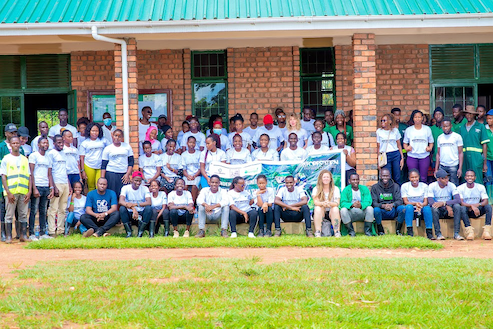Given the current challenges of climate change, the loss of biodiversity, deforestation and landslides in Uganda, over 100 climate change activists choose to wrap up the month of April in Nandere Forest to mark Earth Day 2023 running under the theme “Be part of the green revolution”.
According to Ndyamuhaki Isaac, the Programs Manager-Circular Economy the Green Africa Youth Organization Uganda (GAYO Uganda) said the event was conducted because there is an urgent need for widespread actions at every level to promote ecosystem restoration.
Together with local partners, GAYO Uganda supported the restoration of 3.5 hectares of degraded land in Lazarus, Nandere community forest through planting 4000 rich indigenous species.
“These efforts demonstrate a significant step towards empowering grassroots movements and inspiring action to protect our environment. Looking at these efforts, The Earth Month Reforestation event which gathered over 100 volunteers, stands out as a crucial movement aimed at making our motherland a better place.” Ndyamuhaki said.
He added Camping with 100 volunteers in the forest, it was an opportunity to share knowledge on ecosystem preservation and the role of communities.
“Healthy ecosystems provide an extensive range of vital benefits that are essential for supporting local work and subsistence. These range from the fundamental ecosystem services and functions to the cultural and aesthetic aspects that play a role in the welfare of the societies they inhabit. The benefits of restoring ecosystems extend far beyond their tangible advantages, reaching into deep connections, including the shaping of cultural and traditional customs, such as totems and myths that are revered and respected by communities around the world,” Ndyamuhaki added.

This reforestation event was in line with this year’s Earth’s Month theme, which was “Invest in the Planet”. Providing the possibility for individuals to take action in community restoration, reforestation and conservation.
Ndyamuhaki further sighted that the story of interactions between humans and nature are often multifaceted and difficult to fully comprehend. However, events such as the tree planting initiatives during Earth Month serve as a poignant reminder for us to actively acknowledge, safeguard, and preserve our natural environments.
The nature friendly event pulled out other partners like the One Tree Planted and co-led by Asili Kwanza Uganda, Rural Water Initiative for Climate Action (RWICA), and Bethany Land Institute.
GAYO Uganda is inspired by this action and thus advocates to all stakeholders out there to join the effort of ecosystem restoration; we believe in a world where conserving the natural ecosystem would be the number one priority of the masses.
The Lazarus Nadera Community Forest is 612 acres of natural forest being restored, found in Luwero District just outside Kampala City District. The Lazarus’ Forest is a program under the Bethany Land Institute (BLI), a catholic church-founded institute, that started the restoration of the forest as a learning centre for ecological education and reforestation. The BLI are ‘resurrecting’ the only surviving forest in Luwero District, naming it after the Biblical Lazarus who was resurrected from the dead by Jesus Christ.
The forest being restored is the highlighted habitat, but there is excellent birding outside the forest in woodlands, gardens, grassland, bushes & thickets, and even swamp.
On a good you day you will record more than 100 bird species like the Red-eyed Dove, Blue-spotted Wood-dove, African Green Pigeon, Eastern Plantain-eater, Blue Malkoha, Diederik Cuckoo, Red-chested Cuckoo, Hamerkop, Cattle Egret, Hadada Ibis, African Harrier Hawk, Palmnut Vulture, Long-crested Eagle, Lizard Buzzard, Speckled Mousebird, Crowned Hornbill, Black-and-white Casqued Hornbill, African Pygmy Kingfisher, Woodland Kingfisher, Striped Kingfisher, Broad-billed Roller, Yellow-rumped Tinkerbird, Lesser Honeyguide, Speckle-breasted Woodpecker, African Grey Woodpecker, Nubian Woodpecker, Eurasian Kestrel, Red-headed Lovebird, Meyer’s Parrot, Black Cuckoo-shrike, Grey-headed Tchagra, Tropical Boubou, Sulphur-breasted Bush-shrike, Mackinnon’s Shrike, Piacpiac, African Blue-flycatcher, White-chined Prinia, Green-backed Camaroptera, Tawny-flanked Prinia, Red-faced Cisticola, Winding Cisticola, White-headed Sawing, Little Greenbul, Common Bulbul, Ruppel’s Starling, Splendid Starling, African Thrush, Northern Black-flycatcher, Scarlet-chested Sunbird, Olive-bellied Sunbird, Green-throated Sunbird, Black-necked Weaver, Spectacled Weaver, Vieillot’s Weaver, Village Weaver, Golden-backed Weaver, Compact Weaver, Black Bishop, Grosbeak Weaver, Bronze Mannikin, Black-and-white Mannikin, Black-crowned Waxbill, Red-cheeked Cordon-bleu, Brown Twinspot, Red-billed Firefinch, Pin-tailed Whydah, Northern Gray-headed Sparrow, African Pipit, Yellow-fronted Canary among others.
As a doctrine, at the end of the birding at Lazarus Forest, participants are each given a tree to plant and contribute to the reforestation efforts of the institute.

